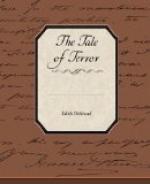parents suffer from what is described by writers on
psychology as “total recall,” and are
unable to select the salient details. The characters
are rather dim and indistinct, the shadowiest of all
being Emma, who has no personality at all, and is
a mere complement to the immaculate Edmund’s
happiness. The good and bad are sharply distinguished.
There are no “doubtful cases,” and consequently
there is no difficulty in distributing appropriate
rewards and punishments at the close of the story—the
whole “furnishing a striking lesson to posterity
of the overruling hand of providence and the certainty
of retribution.” Clara Reeve was fifty-two
years of age when she published her Gothic story, and
she writes in the spirit of a maiden aunt striving
to edify as well as to entertain the younger generation.
When Edmund takes Fitzowen to view the fatal closet
and the bones of his murdered father, he considers
the scene “too solemn for a lady to be present
at”; and his love-making is as frigid as the
supernatural scenes. The hero is young in years,
but has no youthful ardour. The very ghost is
manipulated in a half-hearted fashion and fails to
produce the slightest thrill. The natural inclination
of the authoress was probably towards domestic fiction
with a didactic intention, and she attempted a “mediaeval”
setting as a tour de force, in emulation of
Walpole’s Castle of Otranto. The
hero, whose birth is enshrouded in mystery, the restless
ghost groaning for the vindication of rights, the
historical background, the archaic spelling of the
challenge, are all ineffective fumblings towards the
romantic. The Old English Baron is an unambitious
work, but it has a certain hold upon our attention
because of its limpidity of style. It can be
read without discomfort and even with a mild degree
of interest simply as a story, while The Castle
of Otranto is only tolerable as a literary curiosity.
A tragedy, Edmond, Orphan of the Castle
(1799), was founded upon the story, which was translated
into French in 1800. Miss Reeve informs the public
in a preface to a late edition of The Old English
Baron that, in compliance with the suggestion of
a friend, she had composed Castle Connor, an Irish
Story, in which apparitions were introduced.
The manuscript of this tale was unfortunately lost.
Not even a mouldering fragment has been rescued from
an ebony cabinet in the deserted chamber of an ancient
abbey, and we are left wondering whether the ghosts
spoke with a brogue.
When Walpole wrote disparagingly of Clara Reeve’s imitation of his Gothic story, he singled out for praise a fragment which he attributes to Mrs. Barbauld. The story to which he alludes is evidently the unfinished Sir Bertrand, which is contained in one of the volumes entitled Miscellaneous Pieces in Prose, published jointly by J. and A.L. Aikin in 1773, and preceded by an essay On the Pleasure Derived from Objects of Terror. Leigh Hunt, who reprinted




